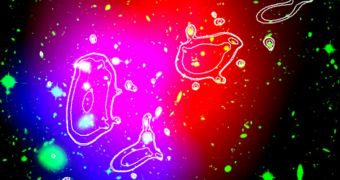The kinetic Sunyaev-Zel'dovich (SZ) effect has been observed for the first time in an individual cosmic object by astronomers at the California Institute of Technology (Caltech) and the NASA Jet Propulsion Laboratory (JPL), both in Pasadena, California.
The team focused its attention on a single, high-speed member of the massive, extraordinarily-dynamic galaxy cluster called MACS J0717.5+3745. Predictions in cosmological theories suggested that the SZ effect should be visible inside such an object, and astrophysicists were finally able to observe it.
This is the first time that this effect has been identified in real life. Basically, it refers to changes that occur in the Cosmic Microwave Background (CMB) – the relic radiation left behind by the Big Bang – when it interacts with massive objects in motion, such as galactic walls and superclusters.
Studies of the MACS J0717.5+3745 cluster have revealed that it weighs a million billion times the mass of the Sun, which means that it is roughly 1,000 times heavier than the Milky Way. Our galaxy is considered a medium-sized cosmic object, with a diameter of roughly 100,000 light-years.
Astronomers were able to observe that three subclusters in the massive accumulation remained relatively stationary at all times (subclusters A, C and D). At the same time, subcluster B was found to be moving towards the core of the cluster at speed of 3,000 kilometers (1,864 miles) per second.
“By using the kinetic SZ effect to measure the velocities of whole clusters relative to the expanding Universe, we may be able to learn more about what causes the universe's accelerating expansion,” says Sunil Golwala, a professor of physics at Caltech and the leader of the new study.
The expert also holds an appointment as the director of the Caltech Submillimeter Observatory (CSO), in Hawaii,which was used to observe subcluster B. The study group determined this formation would run through the core of the cluster at great speed. It will not be able to escape, however, as the larger formation's gravitational pull will capture it and bring it back towards the core.
Within a few billion years, subcluster B will be as stationary as its three counterparts. In the meantime, free electrons in the intercluster medium are excited in MACS J0717.5+3745 to the point where they interact with, and produce changes in, the CMB, as hypothesized in 1972 by Russian physicists Rashid Sunyaev and Yakov Zel'dovich. This is called the SZ effect.
Golwala says that the Multiwavelength Sub/millimeter Inductance Camera (MSIC) instrument, recently mounted on the CSO, will soon be used to gain additional insights into this dynamic galactic cluster.
Details of the new research were published in the Astrophysical Journal, in a paper entitled A Measurement of the Kinetic Sunyaev-Zel'dovich Signal Towards MACS J0717.5+3745.

 14 DAY TRIAL //
14 DAY TRIAL //